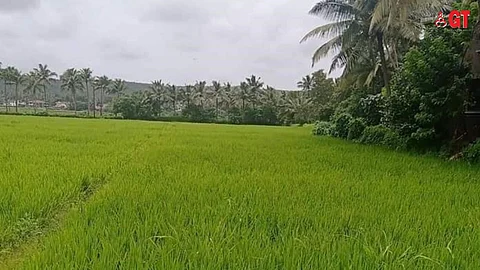

Apart from lovely beaches, Goa is blessed by an abundance of greenery, a sight that is endlessly pleasing to the eye. And, that greenery comes from not just wild vegetation, but also the miles and miles of fields characteristic of the State.
Keeping Goa green is a 365-days-a-year experience that has an additional day in leap years, such as 2024.
WHAT’S IN LOCAL FIELDS
The cowpea is the favourite in fields where rice paddy cannot be grown as the vaingonn crop due to lack of irrigation.
If you go to Parra, the land of the watermelons, you will find watermelon creepers in the fields adjoining the Instagrammable stretch of coconut palm-lined road, known as Maddani. The rest of the fields are occupied by sweet potato and vegetables such as knol-kohl, and radish or yard-long beans trailed on maize plants.
The cowpea is the favourite in fields where rice paddy cannot be grown as the vaingonn crop due to lack of irrigation.
Kalindi Salgaokar, from Bhatti Vaddo in Parra, has her entire family involved in this field, despite some of them being government officials during office hours. Gardening is a good stress-buster.
While the exact variety of the original 'Parra Watermelon' remains uncertain, Darshana Pednekar, from Araddi-Parra, waxes eloquent about how the locally grown watermelons have changed her economic status. She has made a living out of it, raised a family and even built a house.
Dasharath Madgaonkar from Guirim cultivates watermelons in Britto Vaddo, Parra, which is adjacent to his village. Fields know no village boundaries.
GREENING ENDEAVOURS
The Goa Directorate of Agriculture has introduced a variety known as ‘Jumbo’ for cultivation in Goa this season. The Directorate has made a wide range of vegetable seeds available for sale to farmers and gardening enthusiasts at subsidised rates, aiming to encourage vegetable cultivation in Goa.
We are a State that is largely dependent on vegetables procured from other states and distributed by the Goa State Horticulture Corporation Ltd (GSHCL) which was established to break the monopoly of the Goa Fruit & Vegetable Vendors Association.
The Goa Directorate of Agriculture has introduced a variety known as ‘Jumbo’ for cultivation in Goa this season.
Just like the Kadamba Transport Corporation Ltd, the GSHCL has been able to make an impact with generous government subsidies and policy support.
It has approximately one thousand outlets as well as procurement centers to collect and sell local farmers’ produce of a specified list of vegetables, the purchase price of which is declared three to six months in advance.
The GSHCL favours buying vegetables that have a longer shelf life. Solanaceous vegetables like chillies, capsicum, tomato, cherry tomato and brinjal or eggplant, last for more than a week. They last even longer if grown organically, and are good to grow in Goa at this time of the year.
SEED STORIES
The Directorate of Agriculture has brought back the popular ‘Sitara’ variety of chillies and introduced the ‘Alia’ variety this year. Seeds of the cherry tomato variety are priced at more than Rs 1,000 per ten grams, and naturally, has few takers willing to buy it at that rate.
Seeds must be sown in seedling trays or on raised beds, and transplanted when they attain four to six leaves. Seedlings are normally available early on Friday mornings at Mapusa’s Friday market.
Radish seeds of the PCL variety are priced at Rs 6 per 10 grams, while the Multicut coriander variety, at just Rs 2 per 10 grams, are a steal at that price. They have a high germination potential, and good taste as well.
I’m enjoying homegrown ones these days, nurtured with compost made from our own kitchen waste and without any insecticides.
Radish seeds must be sown directly on raised beds or ridges so as to remove the root crop easily, while coriander can be sown directly even on flat beds, and harvested any time before flowering.
Happy gardening in the New Year 2025.
(The author is the former Chairman of the GCCI Agriculture Committee, CEO of Planter's Choice Pvt Ltd, Additional Director of OFAI and Garden Superintendent of Goa University, and has edited 18 books for Goa & Konkan).